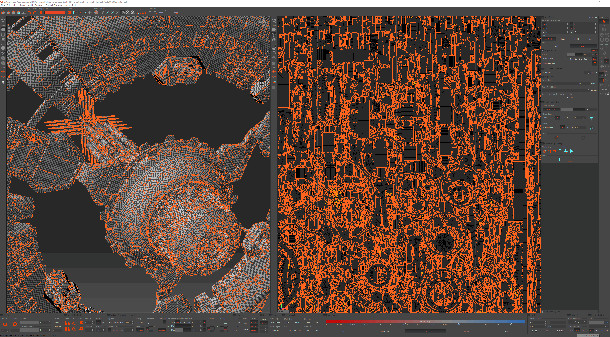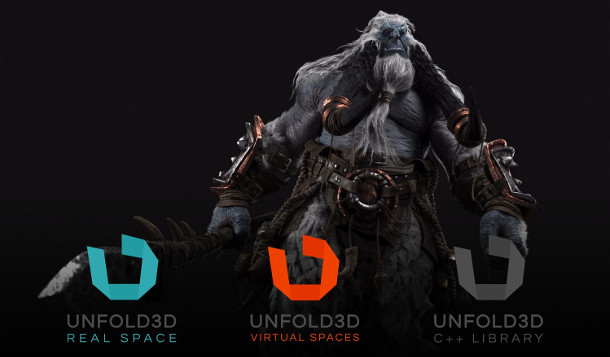Rizom-Lab ships Unfold3D V10 VS and Unfold3D V10 RS
Originally posted on 4 May 2017. Scroll down for details of the commercial release.
Rizom-Lab, a new company founded by Unfold3D author Rémi Arquier, has announced two new editions of the popular UV unwrapping software: Unfold3D RS and Unfold3D VS.
The new editions, which are aimed at product design and games, VFX and VR work respectively – the names stand for ‘Real Space’ and ‘Virtual Spaces’ – are due in beta next month, along with a new C++ library.
The UV unwrapping technology inside Maya and used by many top studios
Over the past decade, Unfold3D has become one of the most popular third-party UV unwrapping packages in the CG industry, in use at studios including Electronic Arts, Ubisoft, The Mill and Animal Logic.
The core technology is also integrated into Maya, and was previously integrated into Softimage.
Until earlier this year, the standalone edition of the software was sold through a publisher, Polygonal Design, but Arquier has since launched his own company to market the new versions directly.
New editions for specific markets
If you’ve used Unfold3D before, the new edition that will be most familiar to you is probably Unfold3D VS.
Designed for games, VFX and VR, the software is designed to unfold and pack the UVs of large production assets, and comes with automated and manual tools for cutting seams and reducing texture stretching.
Unfold3D RS, which is intended for product and packaging design, includes “all the features of Unfold3D VS” but works in unnormalised UV space, respecting the absolute dimensions of the original model.
There is also a new Unfold3D C++ library, designed to enable studios or third-party developers to integrate the technology into their own tools.

UV packing uses UV space more efficiently in the new editions of Unfold3D. According to Rizom-Lab, the 80,000-plus UV islands generated from this 700,000-polygon model were packed in under 15 seconds.
New features: shell groups, improved UV packing, FBX support
Updated 5 May 2017: Rémi Arquier has provided us with details of some of the key features in the new editions. A full feature list will become available closer to the final release.
New features include the introduction of shell groups, which can be defined using selection, material ID or smoothing groups, and distributed in “multiple and highly configurable UDIM tiles”.
UV packing now uses UV space more efficiently, placing smaller UV shells “between and inside the empty spaces of bigger ones”.
The new UV packer handles shell groups as well as locked and stacked shells; and shells and groups can now be assigned properties including vertical, horizontal or automatically optimised orientation.
There are also two new algorithms for automatically generating the seams along which a model’s UVs are unwrapped; two new welding modes; and “lots of little changes and featurettes, like Flip/Align/Parallelize”.
The software is also now compatible with FBX files as well as OBJ files.
Workflow changes: unwrapping updates in real time, single-click workflows for common operations
Every change to the topology of a model – for example, a cut or weld operation – now results in the unwrapped UV layout updating automatically, letting users see the results in real time.
To “reduce the click-fest UV mapping can sometimes turn into”, most features in the software can now be activated by hovering the mouse over the UV layout and pressing a single key. For example, hovering over a UV shell and pressing [U] will re-unwrap the shell.
Arquier also tells us that the update introduces a “better, more ergonomic” rectangular transform tool for all primitive types that enables users to select the transform reference point “in a much easier way”.
Updated 4 July 2017: Unfold3D RS and VS are now available as free public betas for Windows, with Mac versions to follow “in the next few weeks”.
Full pricing hasn’t been announced, although Arquier tells us that it will be lower than Unfold3D Generation 9, which cost €299 for a node-locked Freelance licence or €699 for a floating Network licence.
The new editions will also be dongle-free, unlike their predecessor; and Rizom-Lab will be offering rent-to-own indie licences at €15/month, leading to a full perpetual licence after 12 months.

Updated 4 October: Unfold3D RS and Unfold3D VS are now shipping. They have also gained a version number, becoming Unfold3D RS 2017 and Unfold3D VS 2017.
Since our last update, Rizom-Lab has also published a detailed blog post discussing Unfold3D’s support for multiple UV sets, the UDIM system used in tools like Mari, and support for multiple objects.
Updated 2 November 2017: Rizom-Lab has changed the version numbering system for the software, with the two new releases becoming Unfold3D V10 VS and Unfold3D V10 RS.
Pricing and availability
Unfold3D V10 RS and Unfold3D V10 VS are available for 64-bit Windows 7+ and macOS 10.12.5+.
The licensing model is quite interesting, with major differences between Indie licences – intended for artists and companies earning less than €100,000/year – and Pro licences.
Indie users get the option to rent to own or buy a perpetual licence; Pro users get a rental-only model. Indie licences of both types are nodelocked to two computers, while Pro users can also rent floating licences.
For Unfold3D V10 VS, a perpetual licence costs €149.90 (around $175) and rent-to-own costs €14.90/month ($17/month). Pro licences cost €34.90/month/token ($41/month/token).
For Unfold3D V10 RS, a perpetual licence costs €299.90 (around $351) and rent-to-own costs €29.90/month ($35/month). Pro licences cost €59.90/month/token ($70/month/token).
Neither version is available as an upgrade from the previous release, Unfold3D Generation 9, which remains available from original publisher Polygonal Design.
Read more about the features in Unfold3D V10 RS and Unfold3D V10 VS on Rizom-Lab’s website
